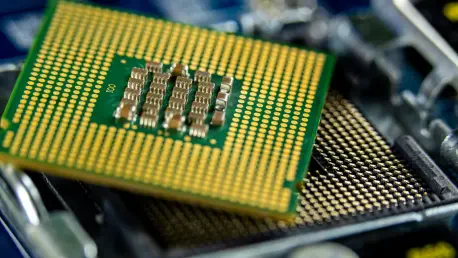The pace of technological innovation continues to accelerate, with silicon signaling chips becoming central to the transformation of optical networks. Silicon-based reconfigurable and programmable all-optical signal processing (AOSP) chips are entering a pivotal era, presenting a significant advancement in the realm of optical communications. These chips promise heightened data processing capabilities, which have become increasingly crucial as the demands of big data continue to grow. At the intersection of traditional electronic data processing and modern optical innovations, these chips embody the potential to revolutionize how data is handled, transmitted, and processed across networks globally. Underpinned by silicon photonic integration, they offer a path toward a cohesive and efficient future landscape in data management, showcasing potential enhancements in speed, efficiency, and flexibility of optical network infrastructures.
The Challenge of Optical-Electrical-Optical Bottlenecks
The historical dependency on optical-electrical-optical (O-E-O) conversion within data networks has introduced inherent inefficiencies, acting as a bottleneck in data throughput and energy consumption. These processes have struggled to keep pace with modern data transmission demands, especially as data rates continue to skyrocket. Historically, all-optical signal processing (AOSP) has faced challenges primarily due to constraints in technology and material limitations. However, silicon has emerged as a leading candidate to address these challenges, with its inherent advantages such as compatibility with complementary metal-oxide-semiconductor (CMOS) technology, low production costs, and robust optical properties. Leveraging these characteristics, significant advances have been made in designing silicon-based integrated solutions capable of handling data within the optical domain more effectively, thereby alleviating some of the inefficiencies associated with traditional methods.
Optical networks of today increasingly demand performance characterized by high capacity and reconfigurability. Emerging silicon-based AOSP platforms are tasked with meeting such performance metrics, often referred to as the 3T (format, wavelength, and bandwidth transparency), 3M (multi-function, multi-channel, multi-network), and 3S (self-perceiving, self-learning, self-adopting) criteria. As researchers navigate these constraints, innovative solutions are being designed to enhance optical network performance and meet burgeoning data requirements. The field of silicon photonics stands at the forefront of this technological evolution, effectively bridging past and future, with research aimed at optimizing these foundational attributes to further integrate and improve the operability and robustness of optical networks.
Innovations Overcoming Material Limitations
In addressing the limitations inherent to silicon, particularly its carrier effects such as two-photon absorption and free carrier absorption, breakthroughs have been substantial. These challenges, including severe light scattering losses and optical and thermal crosstalk, have historically impeded the development of efficient AOSP chips. Recent innovations have seen the introduction of novel fabrication processes and materials that substantially mitigate these issues. For instance, the development of ultra-low loss silicon-based waveguides and microresonators with ultra-high-quality factors is pivotal. These advancements allow for intricate light manipulation, essential for the reconfigurable functionality of optical circuits.
One of the significant technological strides lies in the design of novel waveguides and photonic filters. Implementations such as reverse-biased PIN junction ridge waveguides, slot waveguides, and parity-time symmetry coupled microresonators contribute to an increase in nonlinearity, a critical attribute for performing high-speed logic computations and advanced optical regeneration. The use of these new designs has not only addressed optical losses but has also enabled the realization of complex AOSP functions on silicon chips, broadening their applicability and enhancing their practicality for real-world data processing challenges.
Experimental Validation and Results
Experimental efforts have validated the innovative approaches in silicon-based AOSP chips, exemplified by their successful deployment in high-speed computing and multi-value logic operations. These chips have demonstrated the ability to execute logic computing processes at speeds reaching 100 Gbit/s, along with executing tasks such as signal regeneration with the help of four-wave mixing effects. The integration of Si PIN waveguides has been crucial, facilitating multi-channel amplitude and phase regeneration, critical for maintaining signal integrity over extensive networks.
Furthermore, to support these high-performance requirements, advancements in packaging technologies have been essential. These innovations aim to reduce interference such as cross-talk, vital for managing high-density, miniature, multi-channel configurations that stay energy-efficient. Successes are embodied in the form of four distinct AOSP chips: programmable photonic filter chips, logic operation chips, multi-dimensional regeneration chips, and multi-functional AOSP chips. Collectively, these innovations reinforce the stand-alone processing power and connectivity potential of AOSP chips, taking tangible steps toward more efficient and compact solutions for optical data processing.
Milestones in Performance Metrics
Significant milestones within the domain of silicon-based signal processing reflect stringent advancements in the performance capabilities of these chips. Notable achievements include silicon waveguides with impressively low losses, nearing 0.17 dB/cm, and Q-factors extending to 2.11 million. These metric achievements enable extensive bandwidth and tuning capabilities, with orders of magnitude and spectral range flexibility having been realized. Pertaining to four-wave mixing, conversion efficiencies have surpassed 12 dB, providing essential support for efficient logic and regeneration activities integral to chip operations.
These enhancements culminate in the integration of diverse operational components, which facilitate single-chip systems to process signals at rates exceeding 800 Gb/s. Adaptable to varied modulation formats such as differential phase-shift keying (DPSK) and on-off keying (OOK), these systems provide logical frameworks crucial for optimal performance. The architecture of logical operation units including complete CLU setups and quadrature phase-shift keying (QPSK) regeneration enhances sensitivity significantly, surpassing 6 dB improvements. These dynamics ensure that these silicon signal chips remain at the cutting-edge of technological developments, propelling next-generation optical networks.
Future Implications and Outlook
Looking forward, the continued evolution of AOSP technology heralds significant implications for both classical and non-classical communication frameworks. Key areas of focus include advancing nanomanufacturing technologies and exploring novel materials and packaging innovations. These aspects aim to further enhance the efficiency and density of information processing, pivotal for emerging data processing solutions that demand increasingly sophisticated technologies. These developments promise to reshape high-efficiency communication landscapes, ensuring that emerging applications around computation and communication are well-served by dynamically evolving silicon-based technologies.
The future landscape of optical networks is poised to heavily benefit from these advancements, providing a fertile ground for deploying higher-performance, scalable, and adaptable network solutions. This will significantly influence the data processing frameworks across numerous sectors, demanding a sustained focus on innovation, integration, and scalability as foundational aspects of research and development efforts within this domain.
The Road Ahead for Silicon AOSP Chips
Historically, data networks relied heavily on optical-electrical-optical (O-E-O) conversion, creating inefficiencies and bottlenecks in data throughput and energy use. These conversion processes have struggled to keep up with the rapid demands of modern data transmission as data rates continue to soar. All-optical signal processing (AOSP) has traditionally encountered challenges due to technological and material constraints. However, silicon has emerged as a promising solution to address these issues. Silicon offers compatibility with CMOS technology, low production costs, and strong optical properties, driving advances in designing silicon-based integrated solutions that manage data within the optical domain more effectively. This innovation helps reduce inefficiencies found in traditional methods. Today’s optical networks demand performance rooted in high capacity and reconfigurability. Silicon-based AOSP platforms aim to fulfill performance criteria such as 3T, 3M, and 3S, enhancing optical network performance to meet growing data needs. Silicon photonics is a key player in this technological evolution, working to improve optical network operability and robustness.









